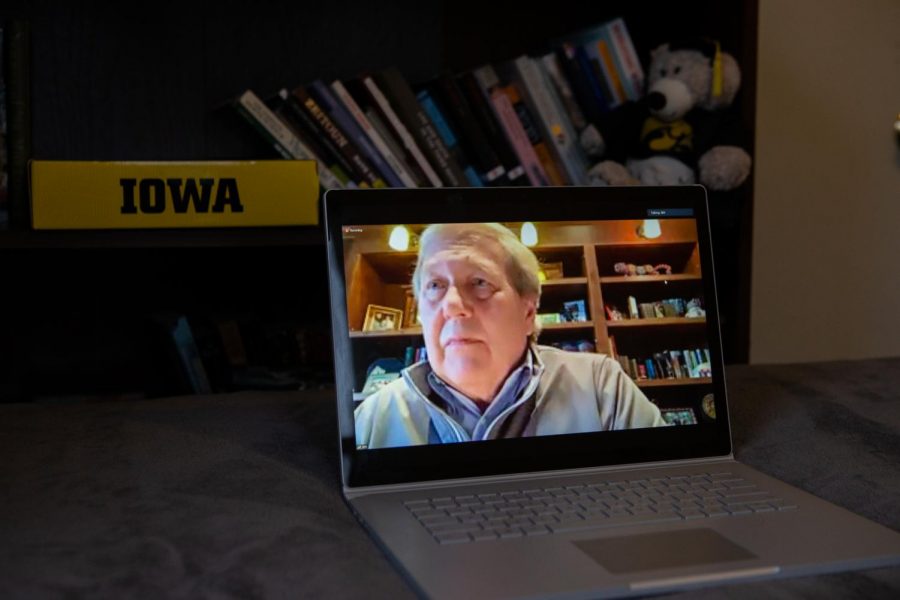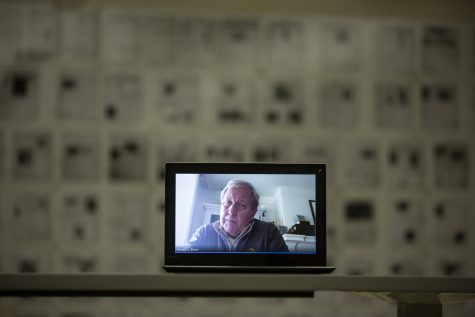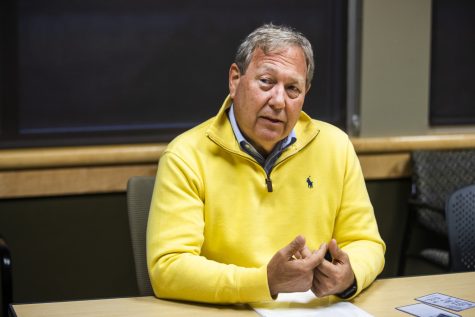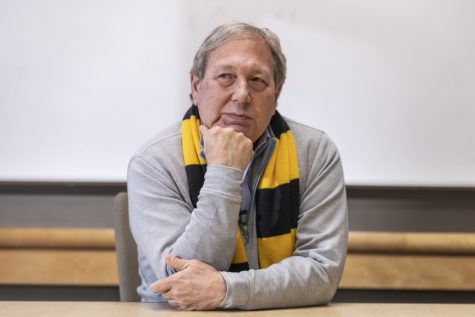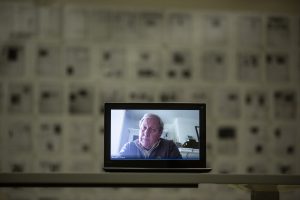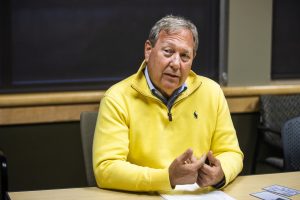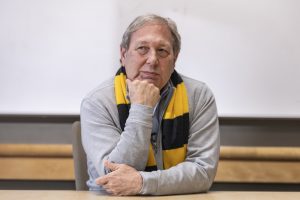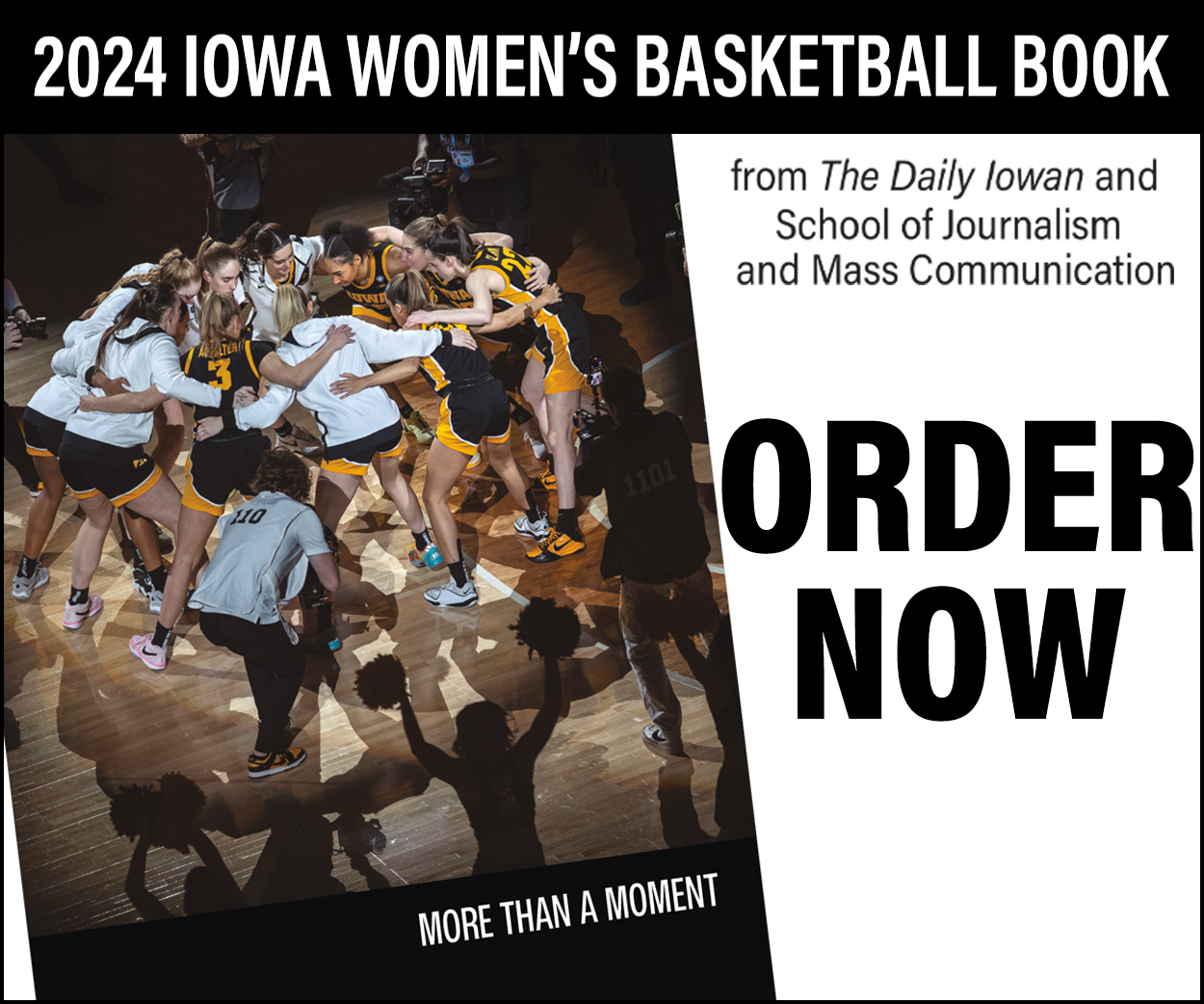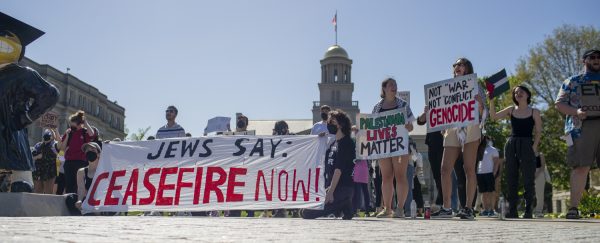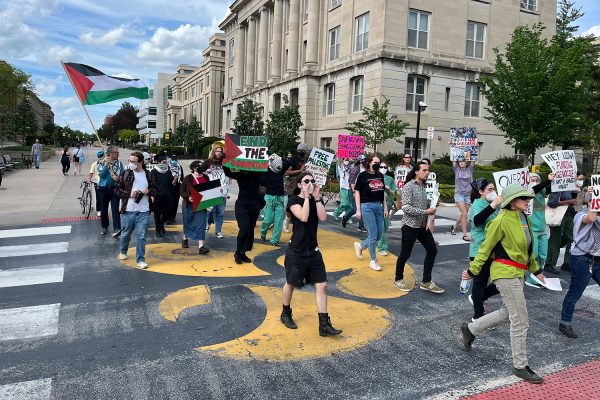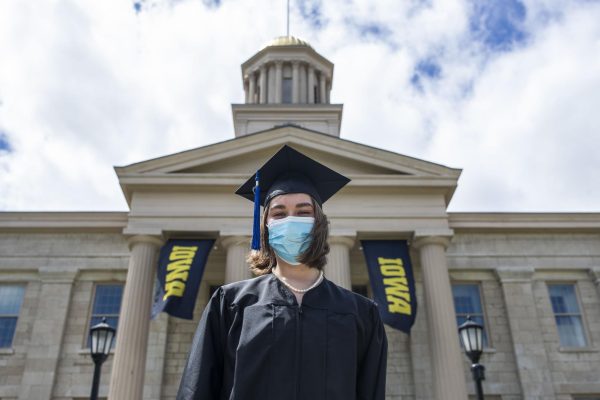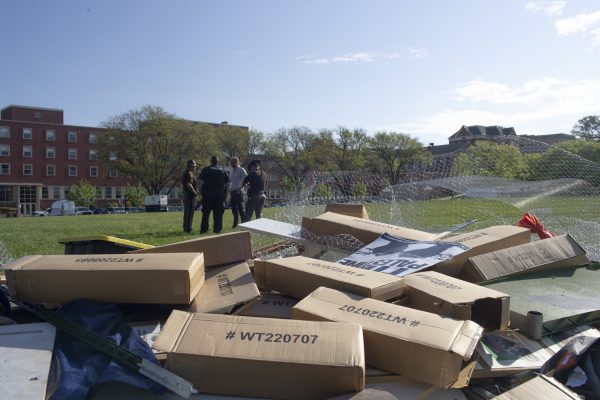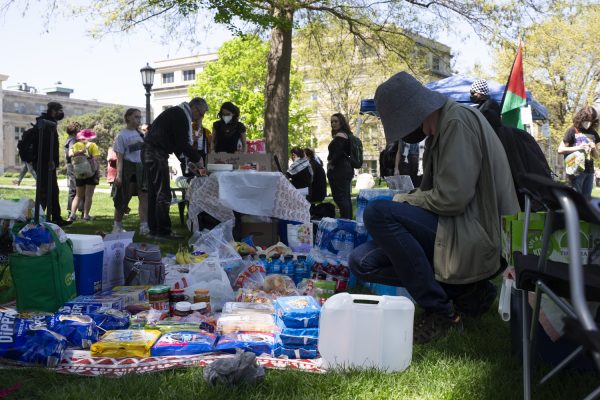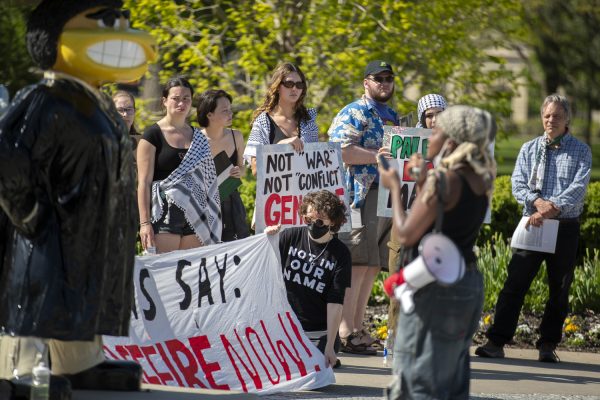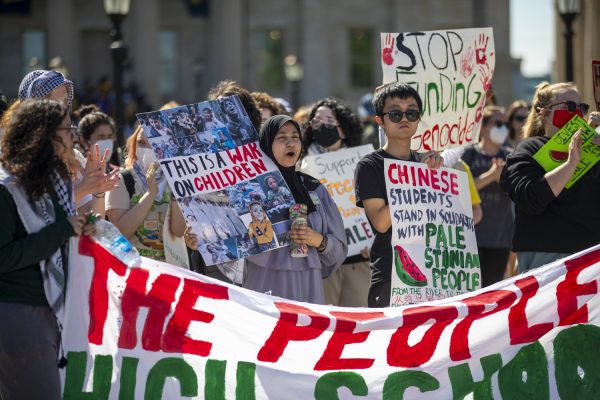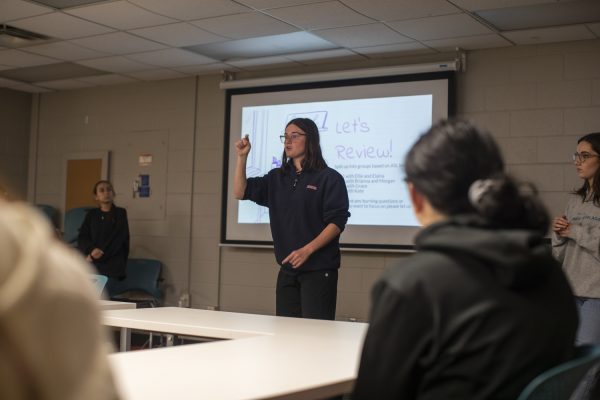Q&A | President Harreld talks presidential search, DEI initiatives, and the spring semester
In a Dec. 11 interview with The Daily Iowan via Zoom, the UI president discussed what he’ll do after his successor is selected, the way forward for diversity, equity, and inclusion on campus, and insights into the spring semester.
December 14, 2020
The Daily Iowan: So where are you Zooming from here today?
President J. Bruce Harreld: I’m in Colorado right now.
DI: I know at the beginning of the semester, some people on social media had said they were wondering if you were in Colorado or on campus. I’m curious how much time you spent on campus?
Harreld: I was on campus the whole semester. Middle of August, I was on campus. I mean, I saw some things also, when with some of the protests and they came to the house and said, ‘Oh, he’s not there.’ No, I was there. And then I left about two weeks ago, roughly.
DI: Around the time as classes went all online. Do you think that that’s a fair question for people to ask, if the president is on campus?
Harreld: Sure.
DI: The presidential search has started with a committee meeting earlier this month. What do you think about the presidential search planning to be finished by April 30? What are you planning to do if a new president is selected by that time?
Harreld: I think it’s wonderful, and I think it will be fast from other searches I’ve watched and other things I’ve heard, but who knows? What I would do is what I’ve always said I would do: I will stick around. I don’t think the committee should feel rushed. I don’t want them to feel rushed. I want them to take their time to find the next great leader for the institution, and then I will help that individual transition into their role. And that could take a week, that could take a month, it’s up to them. I do believe there’s some value — when I joined, there was no one to really introduce me to a lot of people, not only on campus, but also in the state, and even across the country, to major donors. And I am more than willing to do that. That will be up to my successor. And she or he will determine, and if they say, “Thank you, but not needed” — fine.
DI: And if you do end up helping with that transition — if the successor wants that — what will you do if the new president has a different opinion or direction that they want to take the university in?
Harreld: Agree with them. Help them make it happen. It’s the same thing I tell my students in (Presidential Leadership), which is you have a direct responsibility to always express your opinion and to do so professionally and as fact-based as you can. And so if I have a difference in opinion — I think most of us have a difference of opinion on a lot of things — I will express that. And at whichever point the president says, “But I want to do something different.” I’ll say, “OK, let me help you.” My daughter is actually working on finishing her Ph.D. on the topic of followership. And you go to the bookstore or Prairie Lights and see all these books on leadership, and she has correctly, I think, identified that most leaders spend most of their time as followers. And there should probably be some books written on how to be a good follower. And I think this issue you’re on is one of the things I’ve tried — most of my life I’ve been reporting to somebody, and in almost every situation, there’s been some difference of opinion. And it has to be very clear who the decision-maker is. And once the decision-maker decides, I think it behooves all of us to say, “OK, let’s go.”
DI: The Associate Vice President for DEI candidates withdrew after your early retirement announcement in October. What is the way forward for campus DEI initiatives, and why do you think there has been this turnover?
Harreld: Great question, and thank goodness we have such a capable leader in Liz Tovar. And I think the answer to your question is Liz Tovar for the foreseeable future. She’s fully invested. She’s doing a great job. I get great reports of the broad membership of the community. And I think very importantly, when I talk with her, she’s not viewing it just as a little piece of time, or just as an interim. She’s really, really making a difference and doing it for the long term. I expressed to the search committee my frustration with how they got to where they got to. I frankly don’t fully buy it, but I have to be respectful of that committee, and where they got to as a committee. I mean, this was a period where I said — probably in late July? Don’t hold me to that, but somewhere in that time period — I said, “Look, I would be glad to have this report to me.” I went to the search committee and said, ‘But you should take a look at this.’ Because if it then means we have to cancel the search and start all over and take another — however long that would be, say, nine months — that could be an issue. That could be a problem because I think we need leadership now. And hence the reason right about that time period I asked Liz and Kevin, who this position reports to — Kevin Kregel, our provost. He asked Liz to step in on an interim basis. The search committee said, “We do not want to restart the search. We have great candidates. And we think we will be able to get a top-notch long-term leader to campus.” I said, “Fine.” I then a few weeks later started my retirement. And the search firm said something that I still struggle with, which is ‘Even though it’s reporting to the Provost, few candidates will be interested in pursuing the University of Iowa until they know who the next president is.’ Hmm, OK. Why didn’t you say that to me earlier? But we didn’t. And so now here we are. So I think it’s going to be a while. I mean, until we get a permanent head of DEI. But at the end of the day, why on Earth are we so concerned when we have such a great leader with Liz Tovar? I start there and I end there because I think she’s a really talented individual, and she’s really doing a fantastic job. And yet, I don’t like where we are either. But we are where we are.
DI: When the new president is selected, would you consider moving the interim AVP for DEI position to report to the president? Would you recommend that for the new president?
Harreld: Yeah, I’ve recommended that over the summer for us. But I was told we shouldn’t do that because it would lengthen the search. Now that we’ve canceled the search, and we have to start all over, it’s going to take as much time — so there is no more search committee, there is nobody in the system already. And so yeah, I would actually recommend that it does report to the president. But I will tell you, the number of other organizations do not have it reporting to the president. And so again, I would be respectful to the new leader. A number of other organizations have this as an important, critical component of their human resource team, and embedded in that, which could also be — I mean, I’ve grown up, most of my life the diversity organizations have been part of HR teams. And for obvious reasons, because of the recruiting, the retention, and the other policies that are in there. So again, I would be respectful. I would make the recommendation that in our environment — given the start and stop for over how many years now that we’ve gone through here — that it is really, really important and should report to the president. On the other hand, the president has all the right in the world to make the decision.
DI: Is it possible, or would you consider, restructuring the interim position so that Liz Tovar reported to you?
Harreld: No, because I’m not going to upset the process here. We’ve already got it in place. I mean, if there were a really important reason to do that, like there’s something that isn’t going to get done without my imprimatur. I talk to Liz on a frequent basis. I have no concerns. She’s got my number, she calls direct, we meet together. So I don’t know what that solves other than optics. I want to leave it to the next president to do as she or he thinks is appropriate. And I think if I move it now, it’s kind of jumping it. It may not be fair.
DI: There were a couple of faculty members of color at a recent Faculty Senate meeting who felt as if they were not included in some of the campus development of recommendations and overall campus DEI efforts. Do you have any kind of response of how inclusive the administration has been with developing some of these ways forward for DEI?
Harreld: Yeah, I’m glad they spoke up. It’s interesting, I haven’t gotten an email from them, nor has Kevin, to sit down and talk. Having said that, we have a big table and everyone’s welcome to it. How did we get to where we are? We actually did a fair amount of surveying. We had a number of town meetings, we actually created the original action plan that Melissa [Shivers] delivered and Lena Hill (former Director of the Center for Diversity and Enrichment) started. And so it was a pretty broad community input, and then we’ve updated it several times since then. So, to the extent anyone feels like they haven’t been involved in the process and consulted — goodness, I had multiple small group meetings at the house in late afternoons for several months listening to faculty, not just of color — underrepresented and first-generation. So if anyone feels like they haven’t been included, shame on us. But everyone’s welcome. And I saw your article. I wasn’t in the Faculty Senate meeting when this was raised, but I would just say, “Hey, look, thank you for speaking up. But can we kind of get to the solutions? Can we get to what we are not doing?” And clearly, they will probably say, “Well, you’re not including me in the discussion.” Well, we want to include you, so please come along on the journey. But beyond that, what else are we not doing? And one of the reasons this is now in the Provost office is because we all agree. Two years ago, one of the critical issues that we needed to address was the training and retention and recruitment of faculty. That was like — boom — big issue. And so we said, “Then it really does belong.” And I applaud Monste [Fuentes] saying it belongs in the Provost office. I still agree that’s a big issue and a very important issue. And what we seem to do is not get started.
DI: Do you have any plans for how to get started? Or concrete steps moving forward?
Harreld: I’m investing every moment of energy I’ve got in Liz because she understands it. She’s got a great rapport with a lot of people across the community. She’s working, I think quite effectively, with — I thought — faculty, and she’s got some great plans for training and recruitment and retention. So I’m on her team.
DI: So shifting gears a little bit, this obviously has been a really difficult semester for everyone to navigate as we’ve talked about earlier. At the start of the semester, the University of Iowa and Iowa City made some national headlines for outbreaks of COVID-19 cases, which campus health folks have noted are the result of off-campus behavior. How do you and the university plan to avoid a similar outbreak when bringing students back for the spring?
Harreld: All of us are spending a lot of time on just that issue. The Critical Incident Management Team is meeting several days a week and talking a lot about that. First of all, and throughout all this, we’ve paid a lot of attention to the Johnson County Public Health Department, the Iowa Department of Public Health, and the CDC and their guidance, which has been shifting as we learn more about this. There was a long period where there wasn’t much support for tested asymptomatic patients or students, members of our community. And I think it’s still a difference in opinion on that. But one of the things we’re really thinking about is more surveillance testing as people come back to campus. There are a couple of institutions that have announced, I believe, one of my own alma maters Purdue is having some level of discussion about, “You can’t come back unless you’ve been tested somewhere in your home environment. So please don’t even come into Tippecanoe County, in Indiana.” I’m not so sure we could even do that legally — that may be a little extreme — but they’re considering those types of actions. They’re also considering, “Should we be doing a lot of testing in our community for the first couple of weeks?” I suggested, like, probably earlier this week, to some people on the CIMT in a conversation, maybe we should phase our students coming back so we don’t have a big crush. A quarter over, you know, maybe over a couple of weeks at a time would relieve some of that pressure. I think to your earlier point, we ought to talk a lot about the off-campus restaurant and bar scene and the night scene. Because if we do all that testing, which feels good, it’s only good for the moment of the test. And if people are going to have environments around the campus that are really, really dangerous, and the rest of the county’s not doing things to keep people out of those sorts of environments, then I don’t know. I mean, I kind of think, “Here we go again.” And so I’m giving you a lot of plausible answers here because I think it’s still very fluid. And, of course, the biggest piece of fluidity is “Where is the virus now?” We all thought that there would be a spike after Thanksgiving. It hasn’t gone down dramatically from there, but it’s stable. We haven’t seen that spike. And keep in mind, when we report the numbers, we’re talking about self-reported numbers wherever our students are. So those numbers you see for us on a daily basis have got a lot of our student colleagues in some other part of the country.
DI: So a couple of the options, including phased students coming back, would require some planning on behalf of students. Do you have a timeline of when you’ll announce?
Harreld: No, I’m going to let them. I think this is one of those — they need to work and work and work. And I think if we put artificial time pressures — I think that by and large next semester is going to look a lot like this semester, unfortunately. I mean, I’m with them on that. I had to teach and it’s just not fun. But I think the safe thing to do until we get a vaccine well into a lot of arms — and that’ll probably take us well into the spring, if not late spring to do — I think next semester is going to look a lot like this. Therefore, if we had to say, “Hey, all of you [whose] last name starts with H, stay home for an extra week, enroll in your classes through online.” I think we could do it. So, I think we have flexibility here, and I think rather than say, “We’re going to announce it in a week, and we need to have an answer,” let’s work the issue. Let’s watch and see where the virus is going. Let’s understand what the CDC is doing. We’re going to get a lot of answers here in the next two to three weeks on vaccinations, and we’ll see. So, yeah, I hate to give you a nonanswer, but it’s the times. If I had to say anything — I’m pivoting here — but I do think somewhere in this conversation, I want to say thank you to a lot of people. And you know, high on the list that obviously is the CIMT and what they’ve been doing. But also right in the midst of that are the students. I mean, as I walk across campus, we’ve been socially distancing and masking. You guys are doing a great job. I actually thought our residence halls were going to be more problematic. They have not been. We’ve been pretty safe. In fact, you know, a lot of people are staying in the residence halls during this break, so they must be feeling relatively comfortable. I understand food service is still a problem and the frustrations there, but we haven’t had a single student in the hospital. We haven’t had a single case where we can find transmission from students to faculty members — which was a big fear for a lot of the faculty — and I can just keep going. And I think that’s because of the community at large, stepping up, changing their behaviors, which is never easy to do. And it’s funny, I actually stand out and watch on the [T. Anne] Cleary walkway in front of the building where the tourists gather for prospective students. And I see parents out there reaching in their pockets, pulling out masks, because they’re looking around seeing everybody wearing masks. And that’s good. That’s great. That’s what we should be doing. So I just really think it’s been remarkable. On the other hand, it’s been Hell. And I think we’re ready for transition. Final point on all this: please, please, please, to everyone that watches this. Don’t relax because the vaccine is here. It’s not here. You haven’t been vaccinated yet. Vaccines? None of that counts until it’s in our system. And so let’s continue doing what we’re doing until we actually really are vaccinated in. So thank you.
DI: Quick follow up question. So with this surveillance testing, I remember at the beginning of the year at a meeting you had said maybe people who are asymptomatic would be able to be tested, but I don’t think that quite ever materialized until it looks like next semester. And at a September regents meeting you had said that the amount of testing was preventing us from, or in your opinion was not enough, to warrant in-person classes. I guess I’m wondering: what was keeping us from being at that testing level earlier this semester?
Harreld: Oh, I think a whole set of decisions. There was a real shortage on some of the reagents. One of the decisions our CIMT made was to not subscribe to simpler, quicker, less accurate tests. And so we had a pretty high standard. The so-called PCR test with a deep nasal swabbing… and that requires quite a bit of skill to take the sample, and a laboratory overnight running the test. And there were some real shortages and some of the reagents that are necessary for that test. And so there were a whole set of issues. And a number of other institutions, our peers in the Big Ten actually went through some of these quicker, easier saliva-based tests. And they test a lot more people. And they had no change in their results. Per student, per 100,000 students — however you want to measure it — they had the same results we had. In some cases, maybe even worse. We’re kind of like right in the middle of the pack, even though we weren’t doing as much testing. So I really think the public health officials are right, that testing and surveillance testing is a really important part of the puzzle. But if you don’t have the test, you can’t do the surveillance testing. And so then the question becomes, “How do you think about doing pieces of testing across a population like ours?” And our CIMT opted not to do that, and we’re kind of back still now thinking about that. One of the issues is there are multiple types of tests. And I’ve learned — and I’m not an expert, but boy, it is unbelievably complex — and numerous opinions on types of testing, and which one is most reliable, etc, etc, etc. I fought the federal government to be honest with you on this. I think there should have been better standards on testing. WHO had a really reliable test, which is similar to the PCR test, and we decided not to use the WHO test, but to create our own United States test. They got deployed early and had some issues that you can find articles about those issues early on. And then the second area for me has always been that we seem to be fixated on number of cases. And I’ll guarantee you a case is not a case. Some people are really, really, really impacted by this. Some people are not. So we have no severity index, and I’m still frustrated with that because the case count will only go up and will never go down. But then the key question in talking to our medical officials — the UIHC, fortunately, had fantastic experts in this area. And that’s the reason they really don’t stare so much at the cases, as they do hospitalizations, the ventilators, and so they’ve got their own sense of severity. And when you apply that to us, we’ve been pretty as a community. While we’ve had a couple thousand cases, we’ve had no serious cases, which is phenomenal.
DI: Were there ever any questions about a Test Iowa site opening in Iowa City?
Harreld: Yeah, yeah, and there’s one in Cedar Rapids. I don’t want to get into where they are and aren’t, because I haven’t really studied up about where there were discussions about that. But then, once again, one of the things you get into — apparently. Don’t hold me to this — but I’ve been told is that when you go to Test Iowa, the first thing they ask you is “Do you have symptoms?” And if you say no, they actually encourage you not to come and take the test.
DI: Oh, that’s not been my experience. I’ve been able to get it [a test].
Harreld: Yeah. That’s why I said I’m not — I haven’t gone through that process, but they were also having a shortage. Somebody told me that about Cedar Rapids, specifically. Again, I don’t want to get into creating rumors or not — somebody should always double-check this — but yeah, we had discussions about having a Test Iowa, bringing it to campus. And here’s the irony of that: do you know where the lab work gets done for Test Iowa?
DI: Over at the State Hygienic Lab.
Harreld: The State Hygienic Lab. And they’ve gone from one shift to two shifts to now three shifts. And I don’t know, they’re doing, I’ve lost track, but let’s just say upwards of 6,000 tests a day. And so as we put more and more tests through Test Iowa, it sounds great because you can do the testing, but someone’s got to do the lab work. And it all comes back to the State Hygienic Lab. And that’s another crew that has just put out a phenomenal amount of work. Ultimately, the company that was marketing Test Iowa actually did recognize that we’re overloading the lab system. And so they helped us procure some more capacity.
DI: So was that the state’s decision to not open it here?
Harreld: Yeah. Yeah, no, I mean, if we could. Well, I don’t know that we would have if we could, to be honest with you, because we had this testing problem. And keep in mind, many things we’re doing are trying to make sure we don’t overload our own hospital system. And while they have, last night, roughly 50 patients in the hospital with CV-19, and that’s down from 90ish a few weeks ago, it’s been coming down and stabilized in that roughly 50 range, they need all the care. Most of those patients are coming from other parts of the state and being flown in. And they tend not to be from Johnson County. Certainly not from our campus community. But we need to be very, very careful that we don’t do something like open a test site that takes all of the testing capacity and the lab work and diverse it because we have some really sick patients.
DI: Other public universities have predicted budget cuts with fewer state appropriations and more losses for fiscal 2022. Are you anticipating having to make drastic budget cuts? And if so, what would be prioritized?
Harreld: Well, I’m not anticipating making any more beyond what you’ve already seen. We’ve had a drastic negative impact in athletics, and we think we know what that is. We had some real issues in our hospital system because of the dramatic reduction in elective surgeries, and it probably took a real toll on the number of patients that needed a hip replacement or something else. And I always want to be careful to define elective surgeries. Anything that’s scheduled, that’s not an emergency — that’s an elective surgery. Next week, you’re going to go have some spinal work done a long time ago, and it was scheduled for a particular day — that’s an elective surgery. So when we had to postpone those elective surgeries to protect PPE, and health care worker capacity, testing capacity, and all the rest, it took a huge fiscal bite on UIHC. And they also had to go through some pretty significant fiscal salvation measures. We kept the rest of the university running, although remotely, and we’re still in that mode. Thank goodness we did the P3, and we’re in the process now of releasing what we’re calling a “year zero,” a half amount of money for some key projects. I just saw today — you’ll probably see it coming across the lines — I think that the revenue estimating committee for the state actually has numbers that look slightly up from where they were. Our appropriation should be stable in the state, and we shouldn’t have a dramatic reduction, nor do I think we’ll have a dramatic increase. So no, the answer to your question is we’re in pretty good shape fiscally. Now, we’ve got issues here and there, we always have those, but no, we’re in pretty good shape. I think the CARES Act, the first round, really, really helped. FEMA, we’ve got some requests into FEMA for some of our PPE and some of the other issues. Now, key to that is also our enrollment. Right? As you know, taking the enrollment down a little bit every year, we’re now probably in the right zone. I think we’re cautiously optimistic about next year, and the enrollment, both at the graduate level as well as the undergraduate level. And I still don’t know, maybe you do, from talking to your friends, where are the gap year students? What are they going to do? Because we actually could see a meaningful increase if we’re not careful. And that would concern me because that would put more pressure on faculty and classrooms and residence halls, and I’d rather wait for that for a year or so to get a little more stability.
DI: Student Government has advocated for a pass/fail option for this fall semester, including sending out a survey where 82 percent of respondents said that they would like a pass/fail option. A peer school, the University of North Carolina Chapel Hill, offered that for this fall semester, and so I’m curious what the thinking was for not offering that, similar to the spring semester?
Harreld: I’ve talked to the Student Government leaders several times about this, including a couple weeks ago. First of all, I need to say right up front, this is not my domain. This is the provost, faculty, Faculty Senate, and accreditation agencies’ domain. Personally, what I said to the students a couple of weeks ago — and it was interesting because Melissa Muller was in the room, and she’s our new Rhodes scholar, but she wasn’t the Rhodes scholar at that point in time just yet — I made a set of comments because I’ve served on a graduate professional school’s MBA admissions committee many years ago. And the issue of sorting out who you’re going to admit at the graduate level is often about the ranking. And grades are a pretty important part of that process. And there were some institutions and individuals that took a lot of pass/fail courses, and you couldn’t rank them relative to others, and we actually put them over in another pile, and said, “We’ll come back to them after we fill up the class” and, and I think that’s a dangerous zone for some people be in. The only reason that Marissa comes up is because she said, “I’m getting ready to apply to medical school. Please don’t put me in a pass/fail mode. I need every bit of that.” And she’s a pretty good student and several other things. So my real concern is: do we understand the long term consequences? Have the students really thought about how important grades might be in applications to something downstream? And they actually admitted they hadn’t done as much of that. And so, you know, it kind of begs the question — I think you said 82 percent of the students that they wanted it — might the other 18 be the people going to graduate professional schools? And what do we do about them? Because I certainly don’t want to put Marissa or others in a bad position. But again, it’s way above my pay grade. I mean, I think that’s where the faculty and accreditation agencies need to weigh in. Interestingly, if all of the institutions, say the AAU and the Big 10 and other places all got together and said, “Let’s do this,” then I don’t think it would be much of an issue. But that’s not what happened in the spring. And, by the way, whatever happened in the spring is a blip. No one’s going to be concerned. But now we’re getting ready to be into the second and third semester, this could be a big slug on someone’s academic career that could have a big asterisk on the transcript. I have a lot of courses I took as an engineer that I would like to have an asterisk, but we don’t think that’s right.
DI: We had just a question on what kind of metrics you’re using to determine when we should return to normal campus activity, or ramp up maybe doing more in-person classes.
Harreld: You’ve seen our dashboard, you’ve seen the greens and the reds. We all look at that. But I will tell you, the biggest thing I’m looking at is the Department of Public Health and their advice. And I feel it’s maybe shifting a little? I mean, I can jump to Europe. My sense of what’s happening right now in Europe, when they shut down all of the educational system, is they now realize that may have been too severe. And they should have shut down much of the nightlife and sporting events and other major gatherings for people, not your age, but more my age, or maybe in between the two of us. Because that seems to be where a lot of the contact tracing is saying it’s really restaurants and bar scenes and those types of events. It’s not nearly as much in high school or elementary schools, or even our own classrooms. And we all know what we’ve done to change air flows and socially distance in our classes and in our labs and wearing the mask, etc. And so it feels like to me, there’s a beginning of a shift and thinking about U.S. policy as it relates to education at all levels. And so I stare at a lot of that. And you know, there has been a little bit of movement here recently about the days of quarantine and isolation, so I stare a lot to my metrics, and if you will, largely listening to our CIMT, our dashboard, and the other professionals. I mean, you don’t want me making up policy with an engineering business background. Period. And that’s one of the things again, I go back to thanking everybody because this is one of the great things about institutions like ours, is we have some of the world’s leading researchers on the virus and epidemiology. And they’ve done a nice job of coming together and collaborating, helping us.
DI: And going off of that, do you have any idea about commencement for the spring? What plans might look like for graduation ceremonies?
Harreld: No, I don’t. And I will tell you, my operating assumption is it’s going to look virtual. And here’s why: we need to plan that, and it’s got a lot of things we have to videotape and get all that together. And if we get all that together, we can then throw it away and have a live one relatively easily. And I hope that’s where we end up. But if we don’t plan now for a virtual one, and it’s going to be live and there’s a “whoops,” it’s hard to go the other way. So right now, we’re kind of planning on things looking, unfortunately for you, a lot like — I know, I don’t like the answer. Nor do you. You shouldn’t. But on the other hand, we’re not going to run risks and it’s a little bit like the trade-off we got into with this whole semester, which was, you know. It would have been far easier just to shut everything down and not have any classes. The next step would have been far easier to have everything only online. But the problem is we have labs. And we have, you know, two sort of big pillars in this institution. One is our science, medical, engineering labs. And the other is our art community that also has some version of studios and labs in their own right. And those two groups who are a massive percentage of our community — that if we actually went to online-only or shut everything down, we’re going to have a lot of your colleagues who are going to lose track in their academic careers. And some of you may not have come back. That worried me a lot. And so, you know, we talked about the impact and underrepresented minorities and first-generation students and all the rest: this issue of how we do what we’ve now done, which is stay open, but safe at the same time. And that kind of spilled, filters, into graduation. I want us to be together and to celebrate, and hopefully, that’ll be what happens, but we need to make sure we’re prepared just in case it doesn’t.
DI: Thank you very much for your time.
Harreld: Thank you very much for all you’re doing. Stay safe. Keep smiling. Good luck next week and on finals papers.



